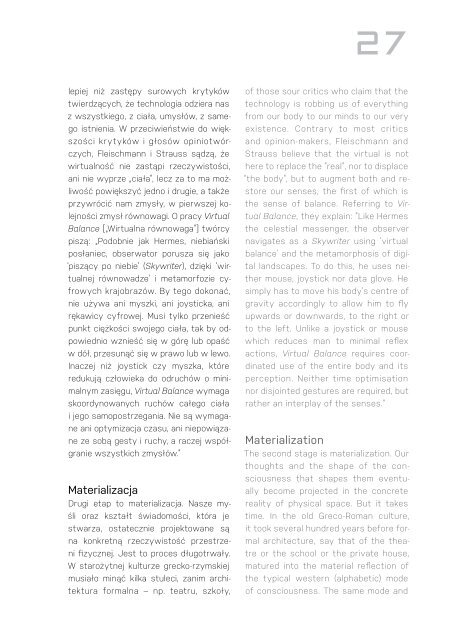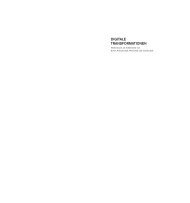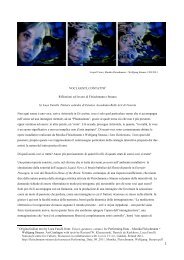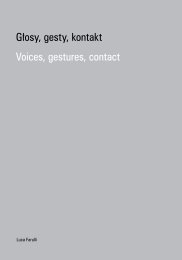Performing Data | Monika Fleischmann + Wolfgang Strauss
Performing Data is a review of Monika Fleischmann´s and Wolfgang Strauss´artistic body of work and a catalogue of their exhibition in Poland 2011. It presents works from Virtual Reality (Home of the Brain) up to Mixed Reality (Murmuring Fields) from Fluid Interface (Liquid Views) up to Floating Interface (Medienfluss) and texts by Ryszard W. Kluszczynski, Derrick de Kerkhove, Luca Farulli. Monika Fleischmann and Wolfgang Strauss from the German Fraunhofer research institute show us an intersection of the body and immaterial digital data. Immersion in data flow causes productive moments of disturbance and suspension, and consequently – a feeling of real physical presence. Fleischmann, Monika; Strauss, Wolfgang: Performing Data | Performowanie danych. National Centre for Culture, Warszawa 2011 in collaboration with Laznia CCArt, Gdańsk, Poland 2011 ISBN 978-83-61587-55-2 (en/pl) http://artline-southbaltic.eu/de/event/performing-data/
Performing Data is a review of Monika Fleischmann´s and Wolfgang Strauss´artistic body of work and a catalogue of their exhibition in Poland 2011. It presents works from Virtual Reality (Home of the Brain) up to Mixed Reality (Murmuring Fields) from Fluid Interface (Liquid Views) up to Floating Interface (Medienfluss) and texts by Ryszard W. Kluszczynski, Derrick de Kerkhove, Luca Farulli.
Monika Fleischmann and Wolfgang Strauss from the German Fraunhofer research institute show us an intersection of the body and immaterial digital data. Immersion in data flow causes productive moments of disturbance and suspension, and consequently – a feeling of real physical presence.
Fleischmann, Monika; Strauss, Wolfgang: Performing Data | Performowanie danych. National Centre for Culture, Warszawa 2011 in collaboration with Laznia CCArt, Gdańsk, Poland 2011 ISBN 978-83-61587-55-2 (en/pl) http://artline-southbaltic.eu/de/event/performing-data/
You also want an ePaper? Increase the reach of your titles
YUMPU automatically turns print PDFs into web optimized ePapers that Google loves.
lepiej niż zastępy surowych krytyków<br />
twierdzących, że technologia odziera nas<br />
z wszystkiego, z ciała, umysłów, z samego<br />
istnienia. W przeciwieństwie do większości<br />
krytyków i głosów opiniotwórczych,<br />
<strong>Fleischmann</strong> i <strong>Strauss</strong> sądzą, że<br />
wirtualność nie zastąpi rzeczywistości,<br />
ani nie wyprze „ciała”, lecz za to ma możliwość<br />
powiększyć jedno i drugie, a także<br />
przywrócić nam zmysły, w pierwszej kolejności<br />
zmysł równowagi. O pracy Virtual<br />
Balance [„Wirtualna równowaga”] twórcy<br />
piszą: „Podobnie jak Hermes, niebiański<br />
posłaniec, obserwator porusza się jako<br />
‘piszący po niebie’ (Skywriter), dzięki ‘wirtualnej<br />
równowadze’ i metamorfozie cyfrowych<br />
krajobrazów. By tego dokonać,<br />
nie używa ani myszki, ani joysticka, ani<br />
rękawicy cyfrowej. Musi tylko przenieść<br />
punkt ciężkości swojego ciała, tak by odpowiednio<br />
wznieść się w górę lub opaść<br />
w dół, przesunąć się w prawo lub w lewo.<br />
Inaczej niż joystick czy myszka, które<br />
redukują człowieka do odruchów o minimalnym<br />
zasięgu, Virtual Balance wymaga<br />
skoordynowanych ruchów całego ciała<br />
i jego samopostrzegania. Nie są wymagane<br />
ani optymizacja czasu, ani niepowiązane<br />
ze sobą gesty i ruchy, a raczej współgranie<br />
wszystkich zmysłów.”<br />
Materializacja<br />
Drugi etap to materializacja. Nasze myśli<br />
oraz kształt świadomości, która je<br />
stwarza, ostatecznie projektowane są<br />
na konkretną rzeczywistość przestrzeni<br />
fizycznej. Jest to proces długotrwały.<br />
W starożytnej kulturze grecko-rzymskiej<br />
musiało minąć kilka stuleci, zanim architektura<br />
formalna – np. teatru, szkoły,<br />
of those sour critics who claim that the<br />
technology is robbing us of everything<br />
from our body to our minds to our very<br />
existence. Contrary to most critics<br />
and opinion-makers, <strong>Fleischmann</strong> and<br />
<strong>Strauss</strong> believe that the virtual is not<br />
here to replace the “real”, nor to displace<br />
“the body”, but to augment both and restore<br />
our senses, the first of which is<br />
the sense of balance. Referring to Virtual<br />
Balance, they explain: “Like Hermes<br />
the celestial messenger, the observer<br />
navigates as a Skywriter using ‘virtual<br />
balance’ and the metamorphosis of digital<br />
landscapes. To do this, he uses neither<br />
mouse, joystick nor data glove. He<br />
simply has to move his body’s centre of<br />
gravity accordingly to allow him to fly<br />
upwards or downwards, to the right or<br />
to the left. Unlike a joystick or mouse<br />
which reduces man to minimal reflex<br />
actions, Virtual Balance requires coordinated<br />
use of the entire body and its<br />
perception. Neither time optimisation<br />
nor disjointed gestures are required, but<br />
rather an interplay of the senses.”<br />
Materialization<br />
The second stage is materialization. Our<br />
thoughts and the shape of the consciousness<br />
that shapes them eventually<br />
become projected in the concrete<br />
reality of physical space. But it takes<br />
time. In the old Greco-Roman culture,<br />
it took several hundred years before formal<br />
architecture, say that of the theatre<br />
or the school or the private house,<br />
matured into the material reflection of<br />
the typical western (alphabetic) mode<br />
of consciousness. The same mode and







